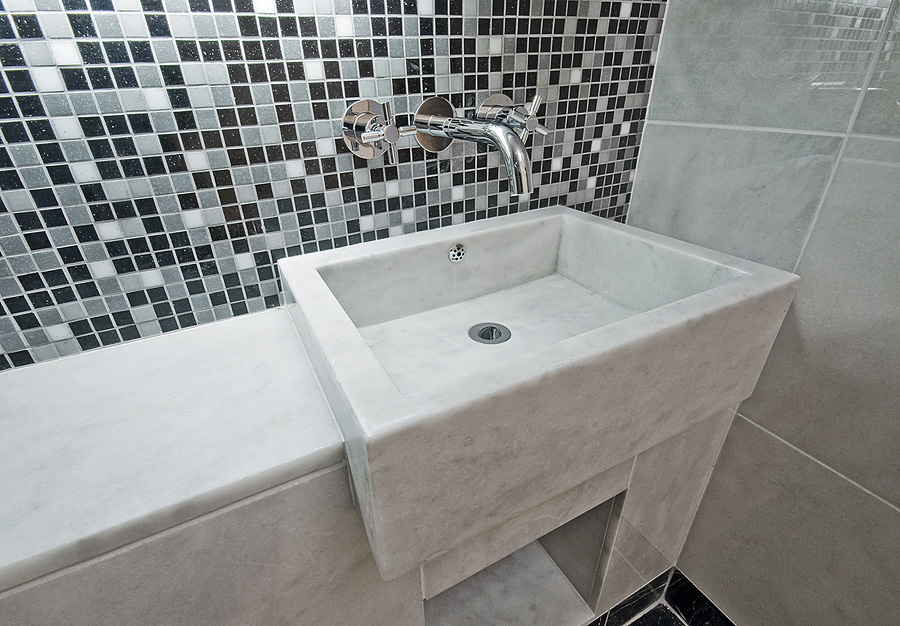Gone are the days when tiles were seen as a purely functional element, simply used to ensure that water did not seep into the walls.
Revel in the choice and range of tiles available and ensure that your new bathroom captures the essence of designer style.
Design tips for your bathroom
Planning the tile design for a bathroom can be a challenge but a few simple tips from our experts will ensure that you love the final result.
• Decide whether you want minimum or maximum wall tiling. Stunning effects can be achieved on a budget.
• Be aware that certain size wall and floor tiles work best in certain size rooms. Floor tiles need to work with the requirements of the room.
•The tiles must be balanced with the size of the bathroom and the overall design. Take into account the position of the bath, shower, vanity and toilet.
• Use lighter tiles on the walls to create a feeling of space and choose tiles for longevity, not fashion, as you want to get more than just a couple of years from the design.
• Consider the layout and space and your colour scheme. Dark colours can enclose a space but can be quite dramatic and contemporary in a larger space. The use of bigger tiles in a small
bathroom will give the illusion of more space.
Care and Maintenance
Proper care and maintenance will prolong the life and looks of any tile you choose although no tile, even a heavy-traffic rated option, is completely impervious. Excess dirt or sand can be abrasive to the tile surface while high-heeled shoes or unprotected furniture legs can also damage your tiles. Bear in mind that high-gloss
tiles will tend to show wear and tear faster than the matt alternative.
The chemicals in bathroom staples, such as deodorants and hair sprays, can have an effect on the tile surface over time so ensure the tile you choose can withstand exposure to acids and alkalines.For most types of tiles, a regular wipe over with a damp cloth is enough to keep the surface looking its best at all times. Abrasive cleaning agents should only be used if the tile’s manufacturer specifically recommends them for the type of tile you have chosen. Make sure that all grout has a mould-resistant
additive to make cleaning of the shower much easier.
Safety
Even slip-resistant tiles can become slippery when wet. Always ensure that tiles to be used in any wet area, such as a bathroom, are rated highest for slip resistance, but do not rely on this
completely. The use of non-slip bath mats can also help.
TILE GUIDE
Ceramic tiles
Ceramic tiles can be defined as a mixture of clays that have been shaped and fired at high temperatures, resulting in a hard body. They can be left untreated or may be glazed. Good-quality glazed ceramic tiles can manage a moderate to heavy traffic flow due to their high durability and are easy to keep clean as they do not retain dust or residues. Plain water or a damp cloth is generally all that is required to keep the tile clean. No polishing or buffing is necessary to maintain the finish. Ceramic tiles are highly durable, easy to install, versatile in application and are a great option for the budget-conscious renovator.
Natural materials
Natural tiles include slate, marble, granite and limestone. Slate is a layered stone tile that, because of its porous qualities, will require the application of a sealant. Marble is a soft, natural tile that generally comes with a polished surface. Both slate and marble require ongoing maintenance. Granite and limestone are hard-wearing, non-porous tiles with excellent stain-resistant properties. Most natural tiles can manage very high traffic flow and are easy to clean with plain water and a damp cloth.
The benefit of using natural tiles is that each tile has its own “personality”. No two tiles will be exactly alike so for those homeowners who prefer a more rugged or rustic look, this type of tile is perfect. Slate, marble, granite and limestone tiles tend to be more expensive than a standard ceramic tile but their durability (when maintained and sealed correctly) makes them a great investment.
Porcelain
Porcelain tiles can be glazed or unglazed. Once glazed they can feature patterns, varying colours and stone look-alike finishes in matt or gloss. They can also be ground and polished to produce a completely flat surface and have a rectified finish, which means the tile edges are ground to an exact tile size with a square-edge finish. Some porcelain tiles even have s mall raised or bevelled-edge finishes to increase slip resistance. Glazed porcelain tiles can handle a moderate to high traffi c fl ow and can be cleaned with water and soap. Porcelain tiles are highly durable and hard-wearing.
Mosaic tiles
Traditionally, mosaics are any tiles, glazed or unglazed, that measure 2in square or less, although today’s clever designs have seen the introduction of a variety of shapes including rectangles and circles. Being small, mosaics are often more delicate than other tiles, making them suitable for light to moderate traffi c fl ow. They also use more grout, making them harder to clean and maintain than larger tiles.






